Aggregate Plan for Demand and Supply Question Answer 2022
VerifiedAdded on 2022/09/12
|6
|1133
|38
AI Summary
Contribute Materials
Your contribution can guide someone’s learning journey. Share your
documents today.
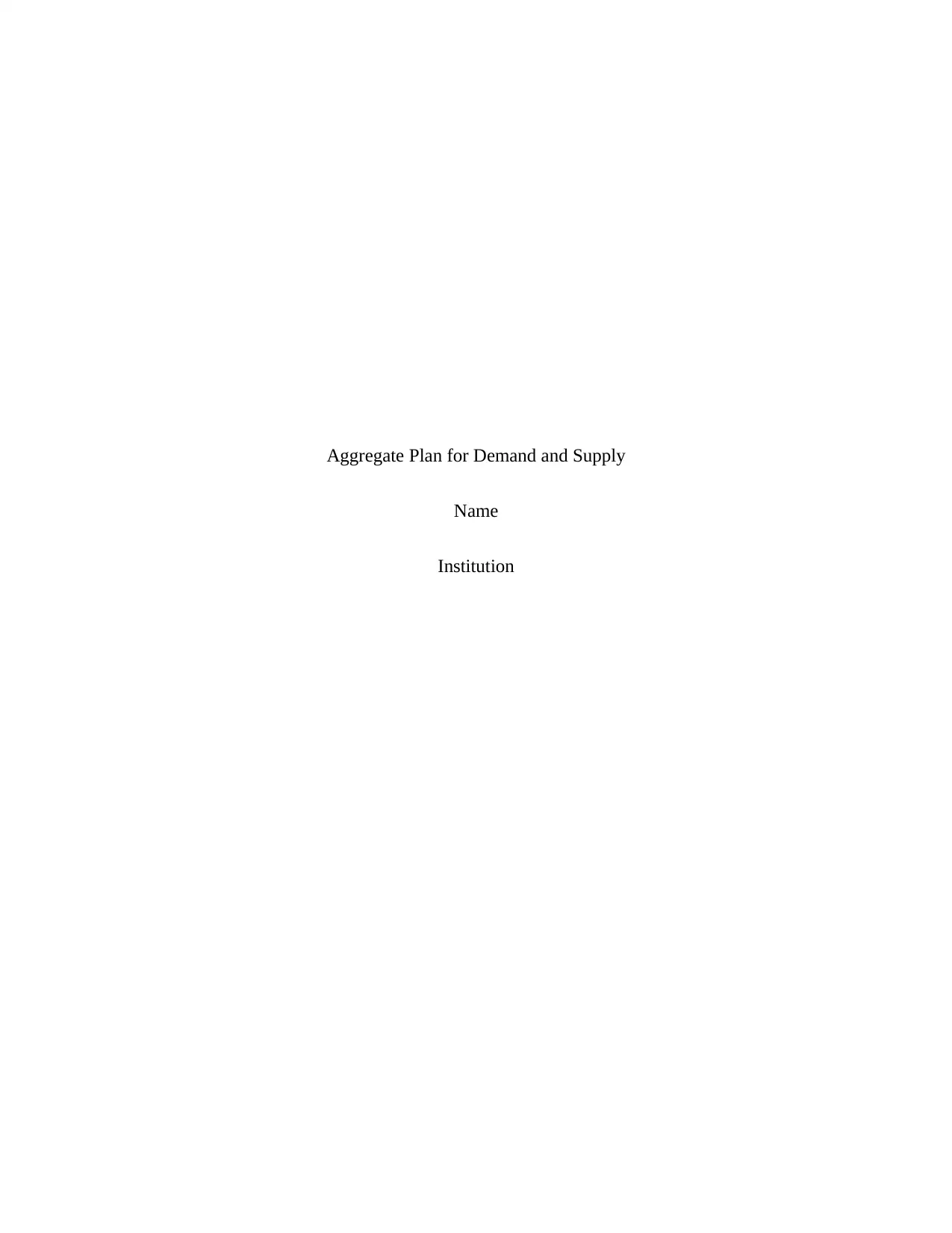
Aggregate Plan for Demand and Supply
Name
Institution
Name
Institution
Secure Best Marks with AI Grader
Need help grading? Try our AI Grader for instant feedback on your assignments.
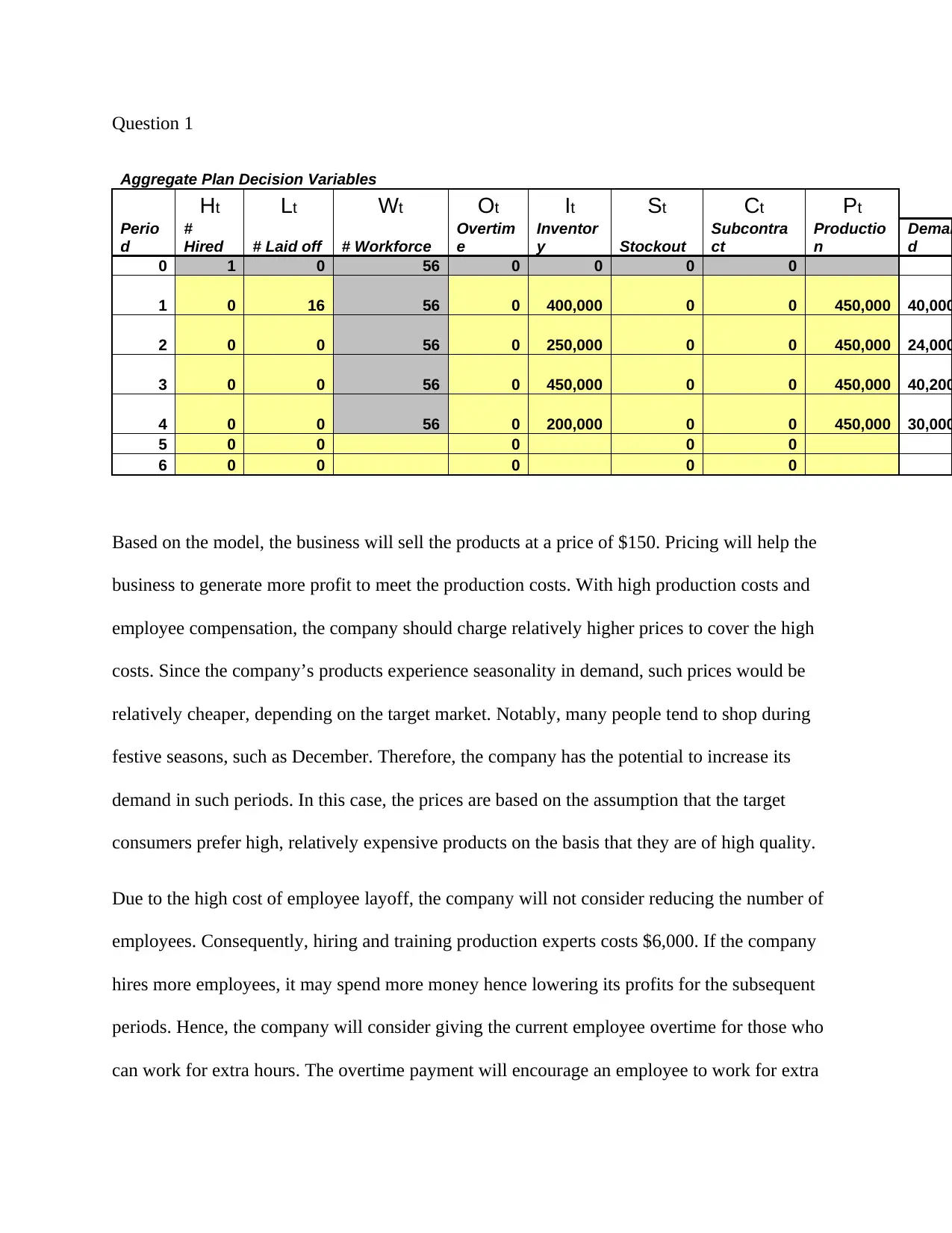
Question 1
Aggregate Plan Decision Variables
Ht Lt Wt Ot It St Ct Pt
Perio
d
#
Hired # Laid off # Workforce
Overtim
e
Inventor
y Stockout
Subcontra
ct
Productio
n
Deman
d
0 1 0 56 0 0 0 0
1 0 16 56 0 400,000 0 0 450,000 40,000
2 0 0 56 0 250,000 0 0 450,000 24,000
3 0 0 56 0 450,000 0 0 450,000 40,200
4 0 0 56 0 200,000 0 0 450,000 30,000
5 0 0 0 0 0
6 0 0 0 0 0
Based on the model, the business will sell the products at a price of $150. Pricing will help the
business to generate more profit to meet the production costs. With high production costs and
employee compensation, the company should charge relatively higher prices to cover the high
costs. Since the company’s products experience seasonality in demand, such prices would be
relatively cheaper, depending on the target market. Notably, many people tend to shop during
festive seasons, such as December. Therefore, the company has the potential to increase its
demand in such periods. In this case, the prices are based on the assumption that the target
consumers prefer high, relatively expensive products on the basis that they are of high quality.
Due to the high cost of employee layoff, the company will not consider reducing the number of
employees. Consequently, hiring and training production experts costs $6,000. If the company
hires more employees, it may spend more money hence lowering its profits for the subsequent
periods. Hence, the company will consider giving the current employee overtime for those who
can work for extra hours. The overtime payment will encourage an employee to work for extra
Aggregate Plan Decision Variables
Ht Lt Wt Ot It St Ct Pt
Perio
d
#
Hired # Laid off # Workforce
Overtim
e
Inventor
y Stockout
Subcontra
ct
Productio
n
Deman
d
0 1 0 56 0 0 0 0
1 0 16 56 0 400,000 0 0 450,000 40,000
2 0 0 56 0 250,000 0 0 450,000 24,000
3 0 0 56 0 450,000 0 0 450,000 40,200
4 0 0 56 0 200,000 0 0 450,000 30,000
5 0 0 0 0 0
6 0 0 0 0 0
Based on the model, the business will sell the products at a price of $150. Pricing will help the
business to generate more profit to meet the production costs. With high production costs and
employee compensation, the company should charge relatively higher prices to cover the high
costs. Since the company’s products experience seasonality in demand, such prices would be
relatively cheaper, depending on the target market. Notably, many people tend to shop during
festive seasons, such as December. Therefore, the company has the potential to increase its
demand in such periods. In this case, the prices are based on the assumption that the target
consumers prefer high, relatively expensive products on the basis that they are of high quality.
Due to the high cost of employee layoff, the company will not consider reducing the number of
employees. Consequently, hiring and training production experts costs $6,000. If the company
hires more employees, it may spend more money hence lowering its profits for the subsequent
periods. Hence, the company will consider giving the current employee overtime for those who
can work for extra hours. The overtime payment will encourage an employee to work for extra
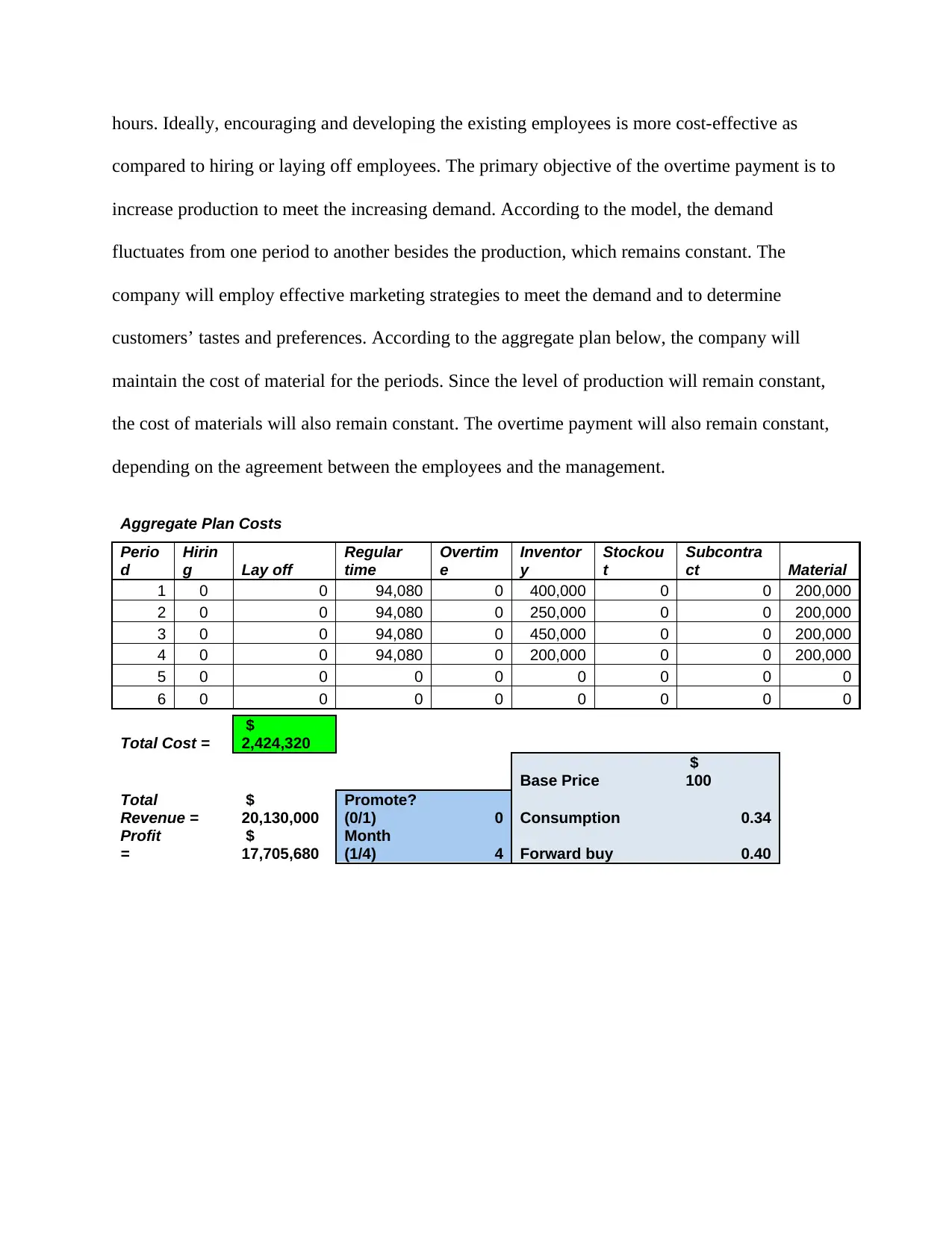
hours. Ideally, encouraging and developing the existing employees is more cost-effective as
compared to hiring or laying off employees. The primary objective of the overtime payment is to
increase production to meet the increasing demand. According to the model, the demand
fluctuates from one period to another besides the production, which remains constant. The
company will employ effective marketing strategies to meet the demand and to determine
customers’ tastes and preferences. According to the aggregate plan below, the company will
maintain the cost of material for the periods. Since the level of production will remain constant,
the cost of materials will also remain constant. The overtime payment will also remain constant,
depending on the agreement between the employees and the management.
Aggregate Plan Costs
Perio
d
Hirin
g Lay off
Regular
time
Overtim
e
Inventor
y
Stockou
t
Subcontra
ct Material
1 0 0 94,080 0 400,000 0 0 200,000
2 0 0 94,080 0 250,000 0 0 200,000
3 0 0 94,080 0 450,000 0 0 200,000
4 0 0 94,080 0 200,000 0 0 200,000
5 0 0 0 0 0 0 0 0
6 0 0 0 0 0 0 0 0
Total Cost =
$
2,424,320
Base Price
$
100
Total
Revenue =
$
20,130,000
Promote?
(0/1) 0 Consumption 0.34
Profit
=
$
17,705,680
Month
(1/4) 4 Forward buy 0.40
compared to hiring or laying off employees. The primary objective of the overtime payment is to
increase production to meet the increasing demand. According to the model, the demand
fluctuates from one period to another besides the production, which remains constant. The
company will employ effective marketing strategies to meet the demand and to determine
customers’ tastes and preferences. According to the aggregate plan below, the company will
maintain the cost of material for the periods. Since the level of production will remain constant,
the cost of materials will also remain constant. The overtime payment will also remain constant,
depending on the agreement between the employees and the management.
Aggregate Plan Costs
Perio
d
Hirin
g Lay off
Regular
time
Overtim
e
Inventor
y
Stockou
t
Subcontra
ct Material
1 0 0 94,080 0 400,000 0 0 200,000
2 0 0 94,080 0 250,000 0 0 200,000
3 0 0 94,080 0 450,000 0 0 200,000
4 0 0 94,080 0 200,000 0 0 200,000
5 0 0 0 0 0 0 0 0
6 0 0 0 0 0 0 0 0
Total Cost =
$
2,424,320
Base Price
$
100
Total
Revenue =
$
20,130,000
Promote?
(0/1) 0 Consumption 0.34
Profit
=
$
17,705,680
Month
(1/4) 4 Forward buy 0.40
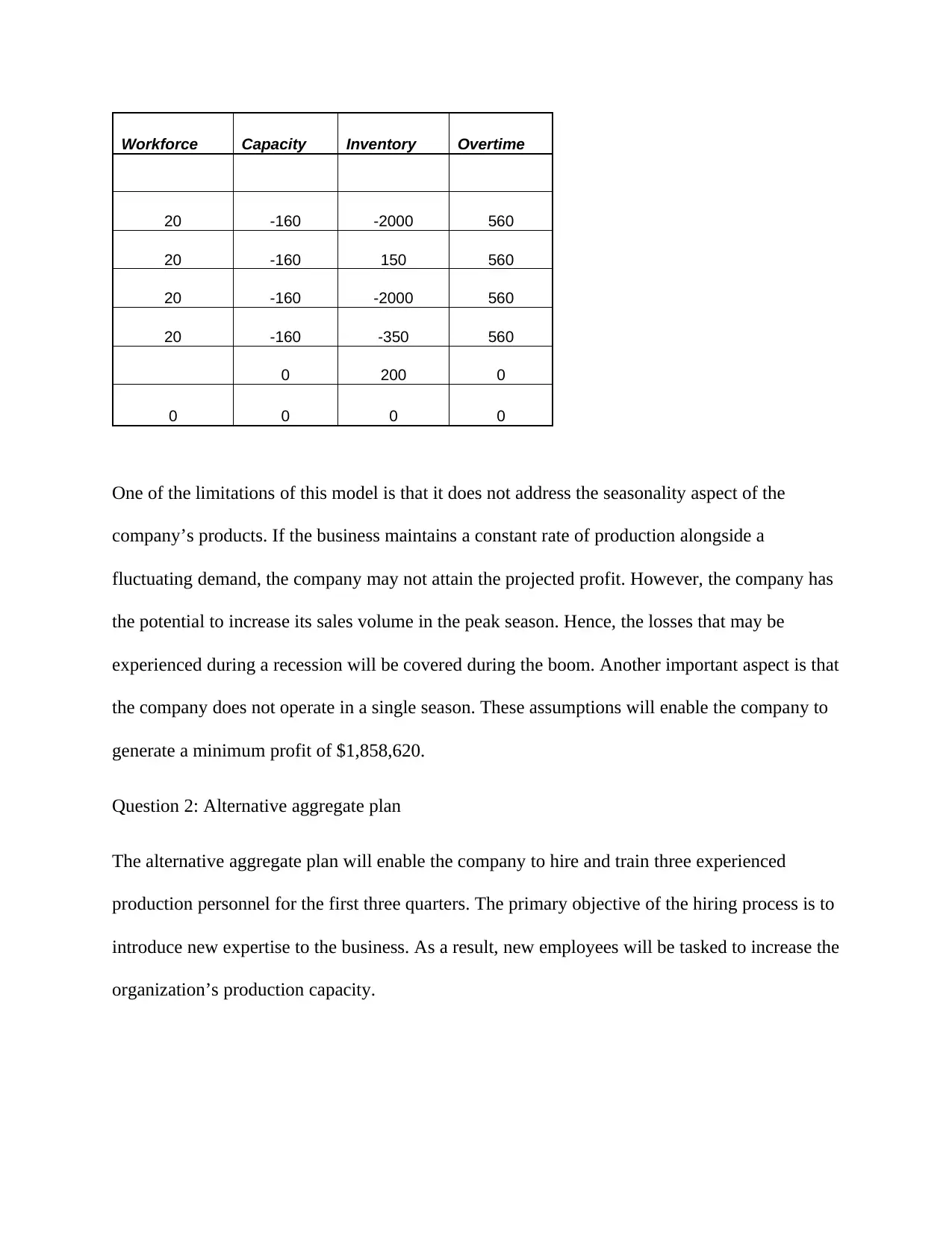
Workforce Capacity Inventory Overtime
20 -160 -2000 560
20 -160 150 560
20 -160 -2000 560
20 -160 -350 560
0 200 0
0 0 0 0
One of the limitations of this model is that it does not address the seasonality aspect of the
company’s products. If the business maintains a constant rate of production alongside a
fluctuating demand, the company may not attain the projected profit. However, the company has
the potential to increase its sales volume in the peak season. Hence, the losses that may be
experienced during a recession will be covered during the boom. Another important aspect is that
the company does not operate in a single season. These assumptions will enable the company to
generate a minimum profit of $1,858,620.
Question 2: Alternative aggregate plan
The alternative aggregate plan will enable the company to hire and train three experienced
production personnel for the first three quarters. The primary objective of the hiring process is to
introduce new expertise to the business. As a result, new employees will be tasked to increase the
organization’s production capacity.
20 -160 -2000 560
20 -160 150 560
20 -160 -2000 560
20 -160 -350 560
0 200 0
0 0 0 0
One of the limitations of this model is that it does not address the seasonality aspect of the
company’s products. If the business maintains a constant rate of production alongside a
fluctuating demand, the company may not attain the projected profit. However, the company has
the potential to increase its sales volume in the peak season. Hence, the losses that may be
experienced during a recession will be covered during the boom. Another important aspect is that
the company does not operate in a single season. These assumptions will enable the company to
generate a minimum profit of $1,858,620.
Question 2: Alternative aggregate plan
The alternative aggregate plan will enable the company to hire and train three experienced
production personnel for the first three quarters. The primary objective of the hiring process is to
introduce new expertise to the business. As a result, new employees will be tasked to increase the
organization’s production capacity.
Secure Best Marks with AI Grader
Need help grading? Try our AI Grader for instant feedback on your assignments.
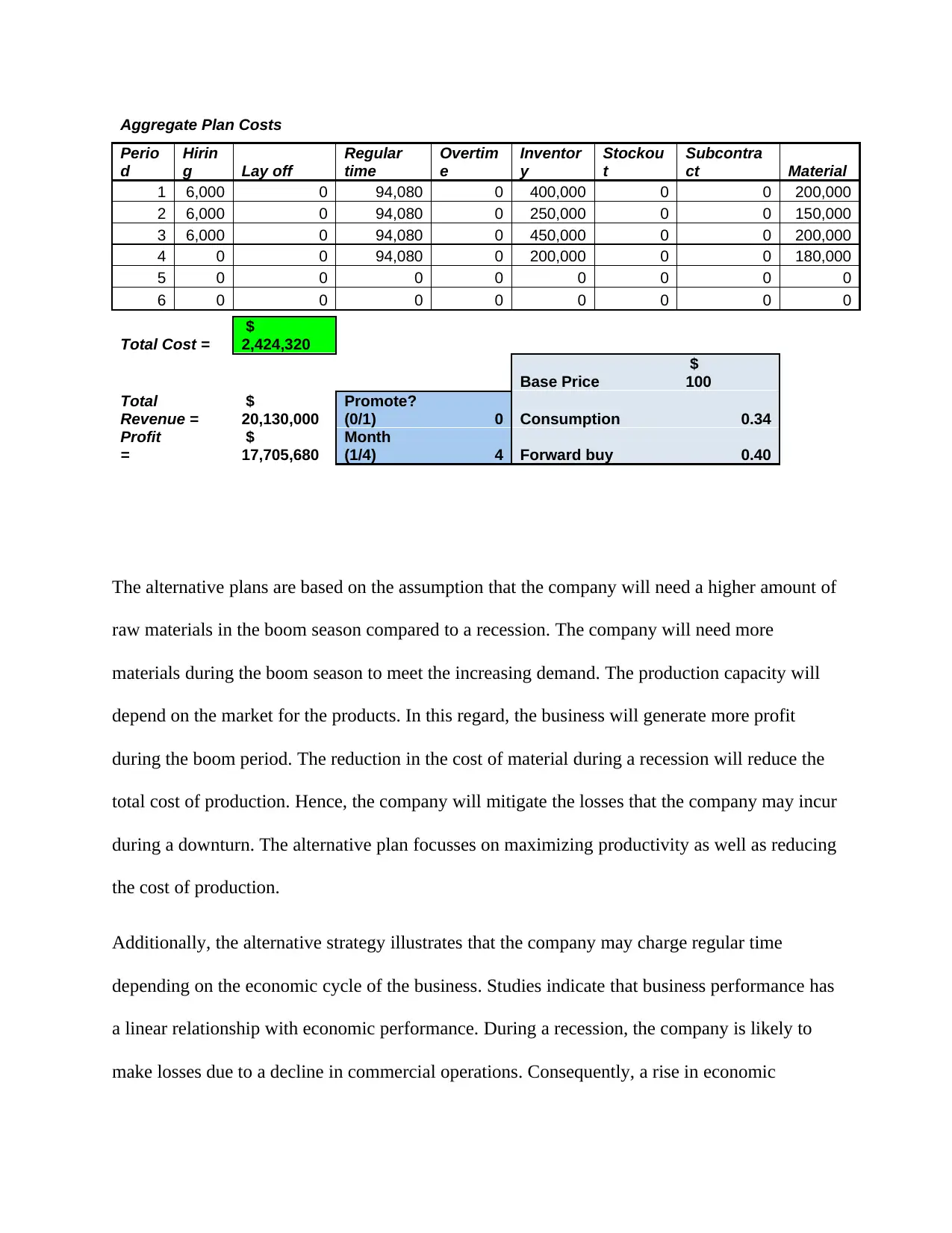
Aggregate Plan Costs
Perio
d
Hirin
g Lay off
Regular
time
Overtim
e
Inventor
y
Stockou
t
Subcontra
ct Material
1 6,000 0 94,080 0 400,000 0 0 200,000
2 6,000 0 94,080 0 250,000 0 0 150,000
3 6,000 0 94,080 0 450,000 0 0 200,000
4 0 0 94,080 0 200,000 0 0 180,000
5 0 0 0 0 0 0 0 0
6 0 0 0 0 0 0 0 0
Total Cost =
$
2,424,320
Base Price
$
100
Total
Revenue =
$
20,130,000
Promote?
(0/1) 0 Consumption 0.34
Profit
=
$
17,705,680
Month
(1/4) 4 Forward buy 0.40
The alternative plans are based on the assumption that the company will need a higher amount of
raw materials in the boom season compared to a recession. The company will need more
materials during the boom season to meet the increasing demand. The production capacity will
depend on the market for the products. In this regard, the business will generate more profit
during the boom period. The reduction in the cost of material during a recession will reduce the
total cost of production. Hence, the company will mitigate the losses that the company may incur
during a downturn. The alternative plan focusses on maximizing productivity as well as reducing
the cost of production.
Additionally, the alternative strategy illustrates that the company may charge regular time
depending on the economic cycle of the business. Studies indicate that business performance has
a linear relationship with economic performance. During a recession, the company is likely to
make losses due to a decline in commercial operations. Consequently, a rise in economic
Perio
d
Hirin
g Lay off
Regular
time
Overtim
e
Inventor
y
Stockou
t
Subcontra
ct Material
1 6,000 0 94,080 0 400,000 0 0 200,000
2 6,000 0 94,080 0 250,000 0 0 150,000
3 6,000 0 94,080 0 450,000 0 0 200,000
4 0 0 94,080 0 200,000 0 0 180,000
5 0 0 0 0 0 0 0 0
6 0 0 0 0 0 0 0 0
Total Cost =
$
2,424,320
Base Price
$
100
Total
Revenue =
$
20,130,000
Promote?
(0/1) 0 Consumption 0.34
Profit
=
$
17,705,680
Month
(1/4) 4 Forward buy 0.40
The alternative plans are based on the assumption that the company will need a higher amount of
raw materials in the boom season compared to a recession. The company will need more
materials during the boom season to meet the increasing demand. The production capacity will
depend on the market for the products. In this regard, the business will generate more profit
during the boom period. The reduction in the cost of material during a recession will reduce the
total cost of production. Hence, the company will mitigate the losses that the company may incur
during a downturn. The alternative plan focusses on maximizing productivity as well as reducing
the cost of production.
Additionally, the alternative strategy illustrates that the company may charge regular time
depending on the economic cycle of the business. Studies indicate that business performance has
a linear relationship with economic performance. During a recession, the company is likely to
make losses due to a decline in commercial operations. Consequently, a rise in economic
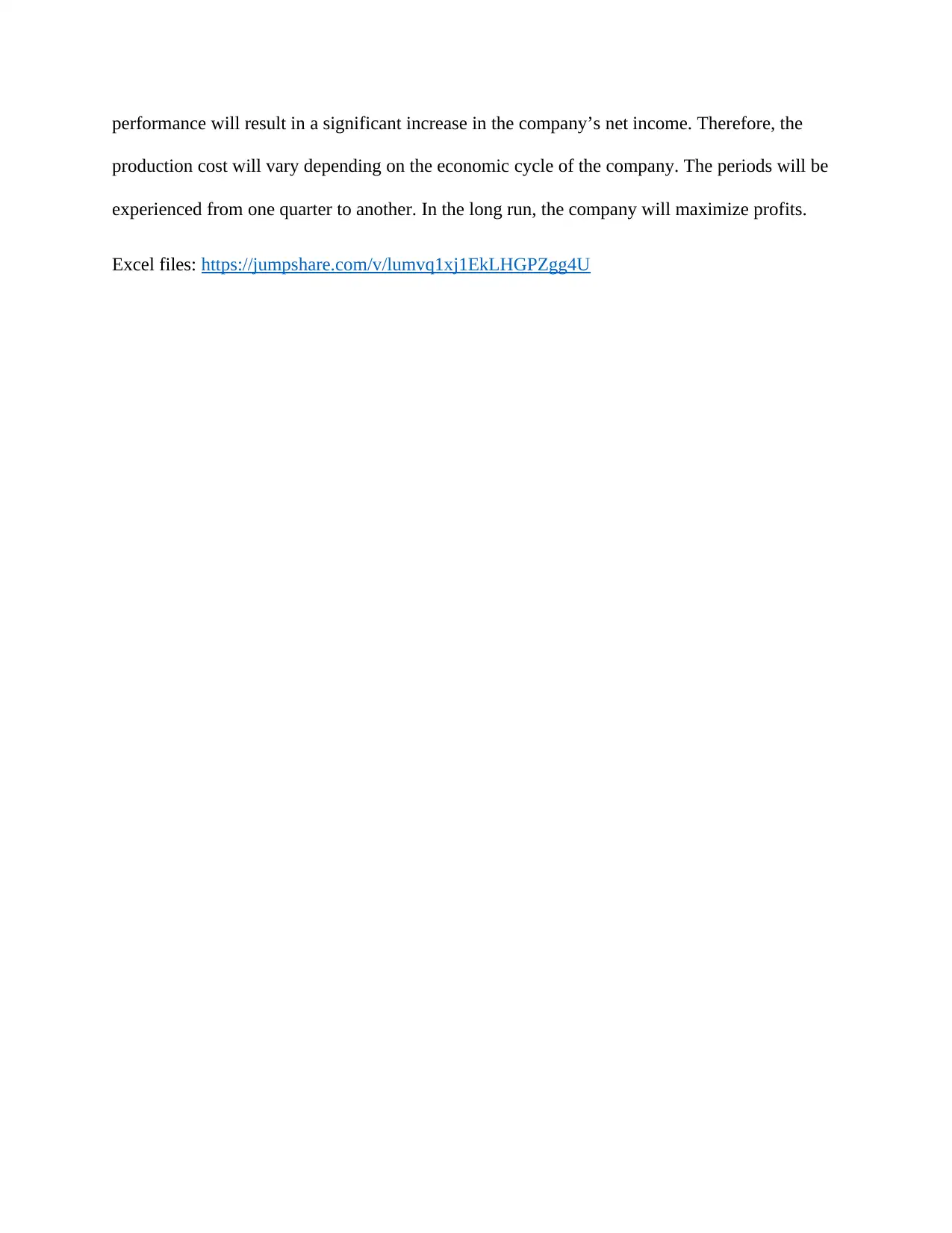
performance will result in a significant increase in the company’s net income. Therefore, the
production cost will vary depending on the economic cycle of the company. The periods will be
experienced from one quarter to another. In the long run, the company will maximize profits.
Excel files: https://jumpshare.com/v/lumvq1xj1EkLHGPZgg4U
production cost will vary depending on the economic cycle of the company. The periods will be
experienced from one quarter to another. In the long run, the company will maximize profits.
Excel files: https://jumpshare.com/v/lumvq1xj1EkLHGPZgg4U
1 out of 6
Related Documents
Your All-in-One AI-Powered Toolkit for Academic Success.
+13062052269
info@desklib.com
Available 24*7 on WhatsApp / Email
![[object Object]](/_next/static/media/star-bottom.7253800d.svg)
Unlock your academic potential
© 2024 | Zucol Services PVT LTD | All rights reserved.
